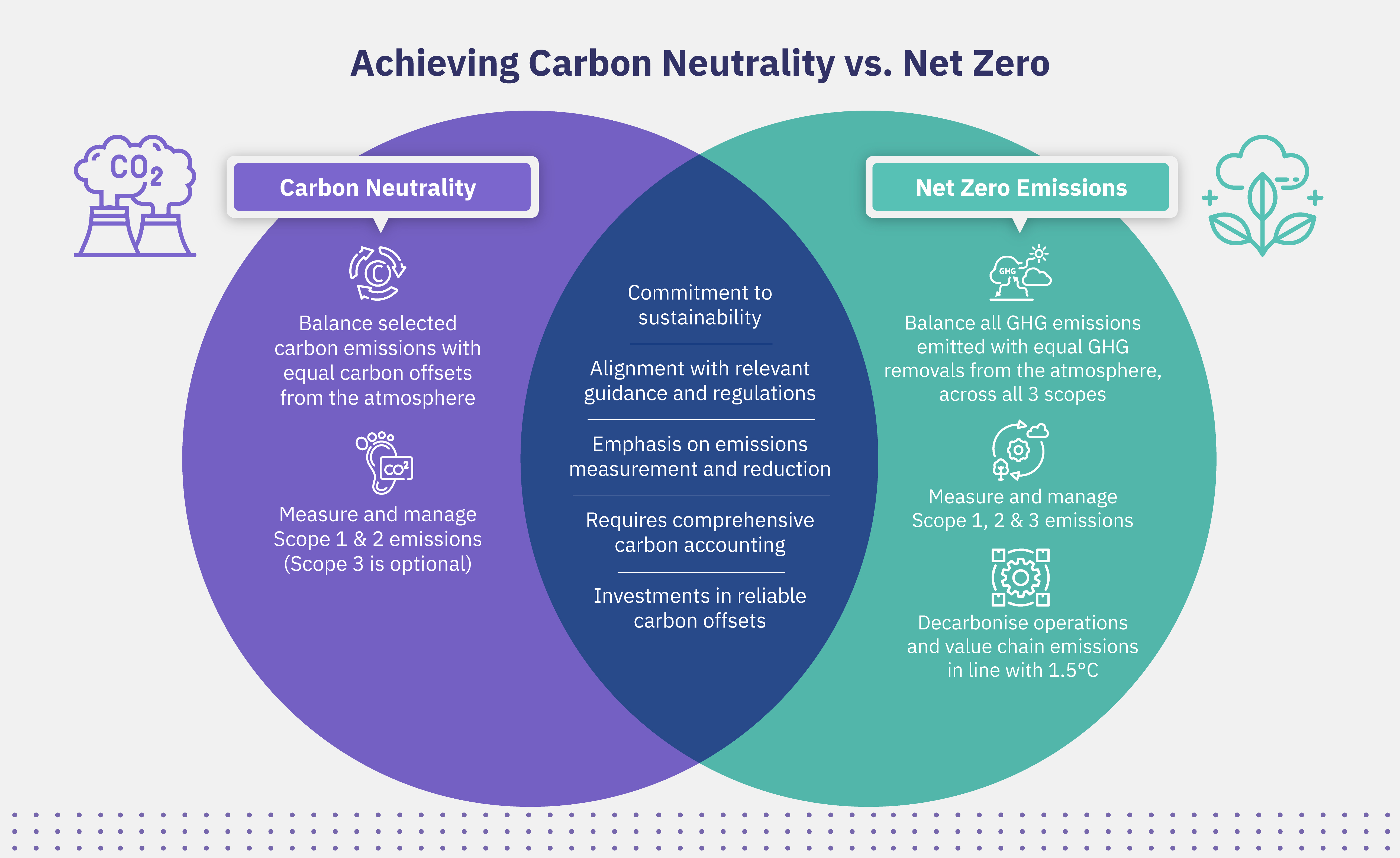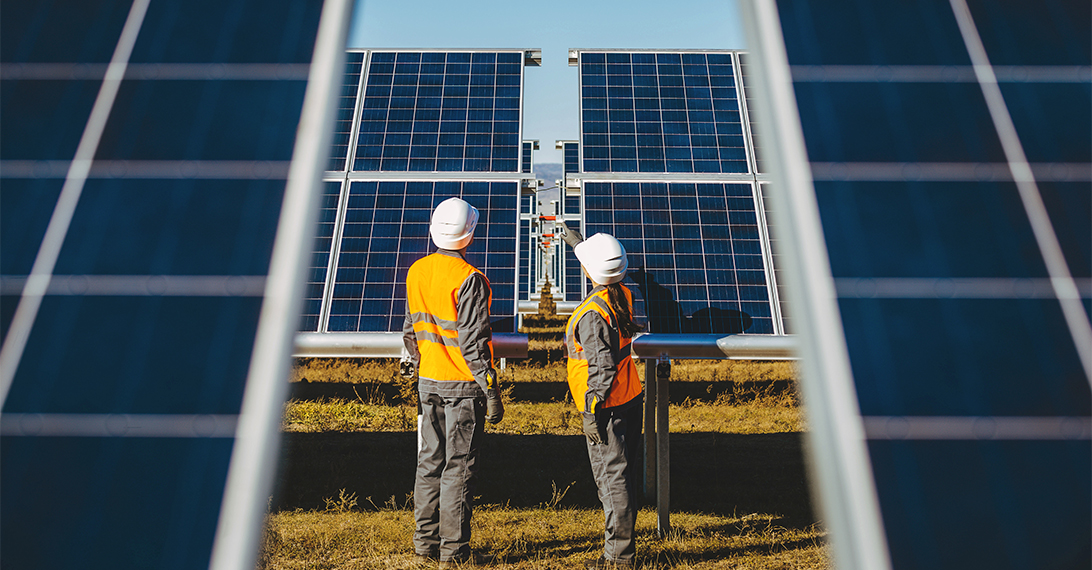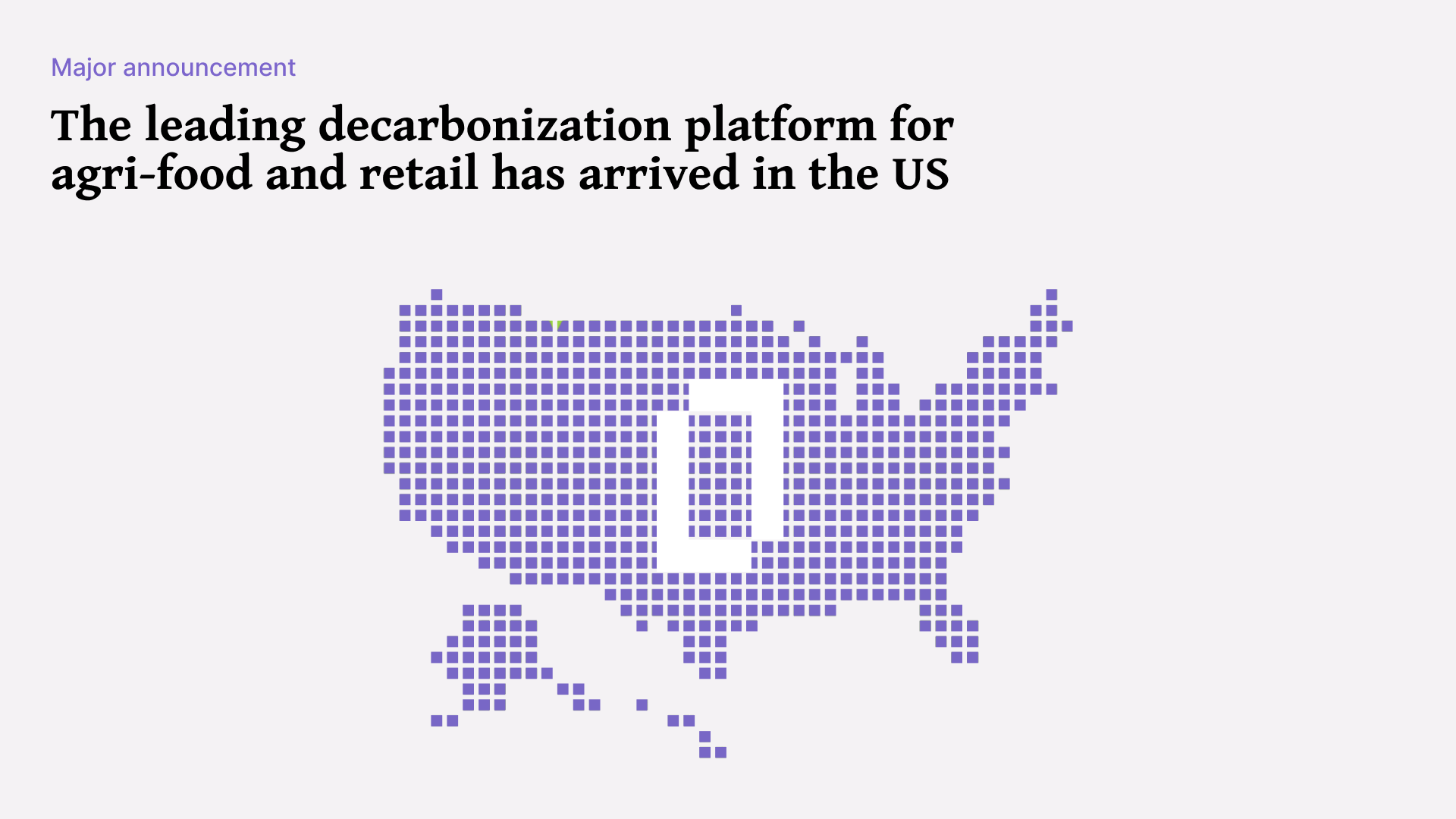Summary
- Carbon neutrality and net zero are goals aimed at different outcomes - carbon neutrality accounts for only carbon and Scope 1 as well as 2 emissions, whilst net zero is holistic - accounting for all greenhouse gas emissions and including Scope 3 emissions.
- In the absence of careful oversight, companies may potentially prioritise purchasing offsets over actively reducing emissions, which claims carbon neutrality without substantial progress in directly reducing emissions.
- The process of setting net zero emission targets is more rigorous, depending on specific mitigation hierarchies and net zero frameworks to ensure accountability.
Introduction
Amidst environmental worries and climate change, consumers, investors, and CEOs emphasize mindful environmental business practices. A World Economic Forum study found that over 90% of CEOs prioritize sustainability, highlighting the need for carbon accounting to meet evolving demands and regulatory shifts. Carbon accounting has emerged as a crucial tool for businesses to measure, manage, and disclose their carbon emissions. In this blog, we provide an in-depth overview of carbon accounting: its definition, the process of conducting carbon accounting, the challenges involved, and the opportunities it presents.
In a world grappling with the consequences of climate change, the terms "carbon neutrality" and "net zero emissions" have now become common parlance. Net zero and carbon neutrality targets encapsulate the urgent need for businesses to transition towards a sustainable economy, prioritising the reduction of carbon emissions. While often conflated, these concepts denote different climate goals and are considered two distinct outcomes of decarbonization. It is important to know the difference between net zero and carbon neutral as recognising the nuanced differences contributes to a more precise definition of climate goals and initiatives. This blog delves into the differences and the significance of achieving carbon neutrality and net zero emissions and outlines how businesses can play a pivotal role in mitigating climate change.
Carbon Neutrality vs Net Zero Emissions
Carbon neutrality and net zero emissions share the common goal of reducing our impact on the environment. Both terms represent the state in which businesses offset the amount of greenhouse gas they emit into the atmosphere by removing an equivalent amount. However, there are distinct nuances between the two, as indicated in the table below.
What is the Difference Between Carbon Neutral and Net Zero?
|
Carbon Neutrality |
Net Zero Emissions |
|
|
What is it? |
- Carbon neutrality mainly accounts for Scope 1 and Scope 2 emissions, while Scope 3 emissions are considered optional. This can prove to be a challenge for companies looking to decarbonise, as scope 3 emissions account for around 90% of an average company’s emissions, depending on the industry. - Carbon neutrality generally focuses only on CO2 and excludes other greenhouse gases such as methane and nitrous oxide. |
- Net zero holistically accounts for Scope 1, 2, and 3 emissions and other GHG emissions as outlined by the GHG Protocol. Net zero entails a comprehensive reduction strategy that spans all aspects of a company’s operations. This approach is grounded in the philosophy that true sustainability requires a complete shift away from high-emission practices. - Net zero is more comprehensive than carbon neutrality as it encompasses all greenhouse gases including methane and nitrous oxide. |
|
Considerations |
- Companies can use carbon offsets to “neutralize” their emissions and claim to be “carbon neutral”. In the absence of careful oversight, companies may potentially prioritize purchasing offsets over actively reducing emissions. This approach might enable claiming carbon neutrality without substantial progress in directly reducing emissions. There is also a added risk of green-washing associated with offsets. - The utilization of carbon offsets requires scrutiny, particularly through the principle of additionality. It is essential that offset projects are accurately quantified and verified, and that they genuinely lead to emissions reductions that would not have occurred otherwise. - Companies may attain carbon neutral certifications like PAS 2060. |
- When setting net zero emission targets, companies can adhere to net zero frameworks like the Science Based Targets initiative (SBTi) Net-Zero Standard, which is rigorously aligned with the latest climate science. - Under the SBTi Net Zero Standard, there is a clear prescribed mitigation hierarchy which encourages businesses to reduce their emissions as much as possible before resorting to off-setting the hard-to-abate residual emissions, its essential components are: 1. Emission reduction: Most companies must reduce emissions by more than 90%, which entails shifting to renewables, enhancing energy efficiency, and reducing fossil fuel dependency. 2. Emission offsetting: After a company has achieved its long-term science-based target of cutting more than 90% of its emissions, it must use permanent carbon removal and storage for the final <10% of residual emissions through nature-based solutions, high-quality carbon credits or Carbon Dioxide Removal (CDR). Net zero is only attained when a company has reduced its emissions and neutralised any residuals. 3. Mitigation beyond the value chain: Companies are also encouraged to take mitigation action that falls outside their value chain, such as peatland or mangrove conservation projects, methane destruction projects, or scaling-up of Carbon Dioxide Removal (CDR) technologies. |
|
Benefits |
Carbon neutrality represents an attainable short-term goal for companies embarking on their decarbonization journeys, making it an ideal starting aim. This strategic initiative provides a solid objective for organisations in the initial stages of reducing their carbon footprint. |
Pursuing net zero emissions is not just an ESG responsibility for businesses, but also a strategic decision to future-proof operations in an increasingly carbon-constrained world. According to a recent survey of Fortune 500 companies, over 60% have set targets to achieve net zero emissions by 2050, highlighting the growing corporate commitment to this holistic approach. |
It is essential to understand the difference between carbon neutral and net zero to recognise the extent of a company’s climate commitment. Understanding the difference between net zero and carbon neutral is important because it influences the stringency, scope, and effectiveness of climate actions tied to these commitments. It helps ensure that efforts to address climate change are based on comprehensive, long-term, and accountable strategies rather than potentially transient or market-driven solutions.

The Role of Businesses
Achieving net zero emissions involves a more comprehensive approach and aligning with ambitious climate objectives. As the engines of economic growth, businesses wield considerable influence over GHG emissions through their operational processes, supply chains, and energy consumption. By prioritising emissions measurement, adopting sustainable practices and working with supply chain partners, they can not only contribute to the collective effort to combat climate change but also benefit from enhanced brand reputation and operational efficiency.
When choosing to commit to net zero vs carbon neutrality, businesses should consider setting a net zero emissions target as the gold standard for their sustainability ambitions. Not only does this necessitate a comprehensive reduction of emissions but also entails greater transparency, and greater credibility, and is aligned with the best climate science.
The Challenge for Businesses
In the pursuit of carbon neutrality and achieving net-zero emissions, companies encounter a significant obstacle – Scope 3 emissions. This presents several challenges, including:
- Data complexity and quality: Companies rely on data from their suppliers to estimate their Scope 3 emissions. This data can be complex and inaccurate, especially in large value chains with multiple suppliers.
- Lack of measurement: Many suppliers do not measure their emissions, and those who do may not be willing to share their data.
- Lack of standard disclosure formats: Companies use different methodologies and metrics to measure Scope 3 emissions, making it difficult to compare data from different companies.
- Complexity and resource intensity: Measuring Scope 3 emissions requires personnel, resources, expertise, and efficient data management processes.
How Terrascope Can Help
To address these challenges comprehensively, Terrascope provides an end-to-end platform that uses seamless data management, smart (AI-powered) measurement and reduction planning and deep sector and climate expertise to address the gaps in this endeavour.
- Manage Data: Businesses have the option to leverage sector-specific data templates or submit data in their preferred formats. The platform will autonomously ingest and process the information, build data profiles, and fill in the missing pieces with 92% accuracy and 5x faster processing speed compared to manual methods.
- Measure Emissions: When businesses utilise the platform, they can gain a comprehensive and granular understanding of their emissions footprint. This enables them to analyze emissions hotspots and drill down into emissions drivers and pinpoint where to focus supplier engagement and data-gathering efforts.
- Plan Reductions: Terrascope unlocks the power of foresight with dynamic 'what-if' simulations and AI-generated decarbonization recommendations. Businesses can explore and compare the impact of specific actions on their value chain, emissions targets, and net zero climate strategy alongside Sustainability Experts and Carbon Data Analysts.
- Implement: The platform fosters collaboration within and beyond organizations, facilitating data gathering, reduction initiatives and progress tracking. This is achieved by monitoring progress against long-term and intermediate targets with shared dashboards and reporting through seamless integrations.
Conclusion
Carbon neutrality and net zero emissions are not mere buzzwords but rather imperatives in a world at the precipice of ecological crisis. The road to sustainability is challenging, but the rewards are immense – a cleaner environment, enhanced business resilience, and a brighter future for future generations. By understanding these concepts, embracing sustainable strategies, and leveraging innovative tools like Terrascope, businesses can better navigate the path toward carbon neutrality and net zero emissions, and be the champions of change.



